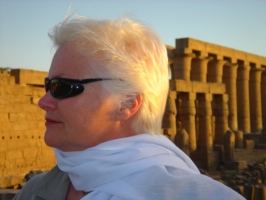My friend and I went on a Cityrama Tour, one of those tours where a group of tourists get driven in Louis XIV opulence aboard a giant, shiny, egg-yolk- colored bus. Champagne country wasn’t a destination I’d have chosen on my own, but my friend wanted to go, so, despite my lived-in clothes and running shoes and natural tendencies, I was dragged into respectability, culture, and the higher classes.
First we took a neck-craning tour of the Cathedrale Notre-Dame de Reims, a UNESCO World Heritage site since 1991, and famous for its smiling angel (shown below). My favorite part of this tour was seeing Marc Chagall’s stained glass windows (also shown below).
 Â Â Â Â
    
Our group then headed to the Piper-Heidsieck winery where we walked between stack after stack of dusty wine bottles and rode in little cars through the chalk caves and champagne-making process. It was like Mr. Toad’s Wild Ride except a lot slower and educational. The P-H people could learn a lot from Disney if they’d study the Peter Pan, Dumbo, Alice in Wonderland, and Mr. Toad rides. Maybe pretend to dump wine on peoples heads or have harvester puppets clutch at people’s clothes.

The complimentary glass of wine at the end was really good, though: something you don’t get after the Peter Pan ride. My friend ordered four more glasses of champagne to check out the different kinds. In the gift shop, I bought a small bottle of Piper-Heidsieck to share with my husband when he visits next week.
Our bus then stopped at some pinot noir vineyards whose vines had been picked clean of their grapes in August. Champagne is made from pinot noir (below, left) and pinot meunier (below, right) grapes. Pinot means “pine” in French, referring to the tight grape clusters resembling pinecones. Noir means “black,” although the grapes are actually dark purple. Meunier means “miller,” referring to the flour-like dusty white down on the underside of pinot meunier grape leaves.
A man in our group found a snail on a vine and called out to his wife, “Escargot, honey, escargot!” My friend found a renegade pinot noir grape that had escaped the harvesters. She snuck it onto the bus, popped it into her mouth, and pronounced it quite good.
We rode a few more minutes to the village of Epernay’s Moet & Chandon complex. M&C trumped P-H on the glitz, with an elegant waiting room, a stiff guide who stood in ballet positions during breaks, and overall snootiness. However, their wine was . . . well, fantastic. Though the quote comes from Dom Perginon, a brand from which M&C seems to be distancing itself, I really did feel like I was drinking stars.
After walking through more chalk caverns where bottles were stacked and rotated, we circled the gift shop where someone could buy very large quanitites of alcohol, either by the bottle or in gift baskets with other delicacies. Should I get a magnum of M&C, wrap it in socks and T-shirts, and take it in my checked return-trip luggage? Nah. Â
                Â
    

You may have seen the ads in the United States “Masquerading as Champagne might be legal, but it isn’t fair.” The ad states, “There are many fine sparkling wines, but only those originating in the chalky hills of Champagne, France, can bear that region’s name.” Now I get the ads.
Once back at the apartment, my friend Googled the Korbel people, a people whose wine she usually drinks. Finding out that Korbel is a “California champagne,” made by using the champagne “method,” my friend declared she would stop drinking it. The French are very definite about the deception of wines made outside the region we’d just visited being labeled “champagne.” I declared I would stop drinking Korbel, too. Besides, Korbel doesn’t ship to Utah.Â






One Comment